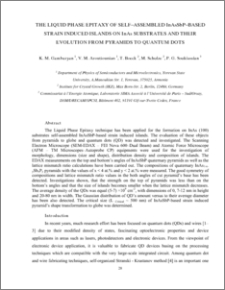Օբյեկտ
Վերնագիր: THE LIQUID PHASE EPITAXY OF SELF–ASSEMBLED InAsSbP–BASED STRAIN INDUCED ISLANDS ON InAs SUBSTRATES AND THEIR EVOLUTION FROM PYRAMIDS TO QUANTUM DOTS
Հրապարակման մանրամասներ:
Ամսագրի կամ հրապարակման վերնագիր:
Armenian Journal of Physics=Ֆիզիկայի հայկական հանդես
Հրապարակման ամսաթիվ:
Հատոր:
Համար:
ISSN:
Պաշտոնական URL:
Համատեղ հեղինակները:
Yerevan State University, Department of Physics of Semiconductors and Microelectronics ; Commisariat à l'Energie Atomique, Laboratoire SIMA associé à l’Université de Paris-Sud/Orsay, DSM/DRECAM/SPCSI, Bâtiment 462, Saclay, 91191 Gif-sur-Yvette Cedex, France ; Institute for Crystal Growth (IKZ), Max Born-Str. 2, Berlin, 12489, Germany
Ծածկույթ:
Ամփոփում:
The Liquid Phase Epitaxy technique has been applied for the formation on InAs (100) substrates self-assembled InAsSbP-based strain induced islands. The evaluation of these objects from pyramids to globe and quantum dots (QD) was detected and investigated. The Scanning Electron Microscope (SEM-EDAX – FEI Nova 600–Dual Beam) and Atomic Force Microscope (AFM – TM Microscopes–Autoprobe CP) equipments were used for the investigation of morphology, dimensions (size and shape), distribution density and composition of islands. The EDAX measurements on the top and bottom’s angles of InAsSbP quaternary pyramids as well as the lattice mismatch ratio calculations have been carried out. The compositions of quaternary InAs1-x-ySbxPy pyramids with the values of x < 4 at.% and y < 2 at.% were measured. The good symmetry of compositions and lattice mismatch ratio values in the both angles of cut pyramid’s base has been detected. Investigations shown, that the strength on the top of pyramids was less than on the bottom’s angles and that the size of islands becomes smaller when the lattice mismatch decreases. The average density of the QDs was equal (5-7) ×109 cm-2, with dimensions of 0, 7-12 nm in height and 20-80 nm in width. The Gaussian distribution of QD’s amount versus to their average diameter has been also detected. The critical size (L Critical ~ 500 nm) of InAsSbP-based strain induced pyramid’s shape transformation to globe was determined.
Բովանդակություն:
Հրատարակության վայրը:
Թվայնացման հովանավորը:
Ստեղծման ամսաթիվը:
Ձևաչափ:
Նույնացուցիչ:
oai:arar.sci.am:23183
Բնօրինակի գտնվելու վայրը:
ՀՀ ԳԱԱ Հիմնարար գիտական գրադարան
Օբյեկտի հավաքածուներ:
Վերջին անգամ ձևափոխված:
Dec 13, 2023
Մեր գրադարանում է սկսած:
Feb 27, 2020
Օբյեկտի բովանդակության հարվածների քանակ:
78
Օբյեկտի բոլոր հասանելի տարբերակները:
https://arar.sci.am/publication/25884
Ցույց տուր նկարագրությունը RDF ձևաչափով:
Ցույց տուր նկարագրությունը OAI-PMH ձևաչափով։
-
Armenian Journal of Physics=Ֆիզիկայի հայկական հանդես
-
Armenian Journal of Physics, 2008
-
Armenian Journal of Physics, 2008, vol. 1
-
Armenian Journal of Physics, 2008, vol. 1, № 1
- ON THE THEORY OF MULTI-PHOTON RESONANT INTERACTION OF STRONG ELECTROMAGNETIC WAVE WITH SEMICONDUCTORS
- SOME PECULIARITIES OF PHOTOREFRACTION IN NEMATIC LIQUID CRYSTALS WITH A SILICON SUBSTRATE
- SOME ELECTRO-OPTICAL CHARACTERISTICS OF SEMICONDUCTOR-LIQUID CRYSTAL INTERFACE
- OPTICAL CONTROL OF THE TERAHERTZ TRANSMISSION OF GaAs-PRISM
- SPECTRAL DEPENDENCE OF THE PHOTOLUMINESCENCE OF CdS1-xSex NANOCRYSTALS EMBEDDED IN SILICATE GLASS
- HEAVY METAL DETECTION WITH SEMICONDUCTOR DEVICES BASED ON PLD-PREPARED CHALCOGENIDE GLASS THIN FILMS
- MANUFACTURE AND INVESTIGATIONS OF ANODIZED TITANIUM OXIDE PHOTOANODES
- DOUBLE-LAYER DIAMOND-LIKE CARBON ANTIREFLECTION COATINGS FOR GaAs SOLAR CELLS
- CONTRIBUTION OF TYPE II QUANTUM DOTS INTO DARK CURRENT IN INTERMEDIATE-BAND SOLAR CELLS
- GENERATION-RECOMBINATION PHENOMENA IN THIN METAL OXIDES FILMS UNDER THE INFLUENCE OF GAMMA RADIATION
- LIGHT-ADDRESSABLE POTENTIOMETRIC SENSOR AS SEMICONDUCTOR-BASED SENSOR PLATFORM FOR (BIO-) CHEMICAL SENSING
- SHORT OUTLINE OF SILICON MOS-LIKE STRUCTURES FABRICATION TECHNIQUES, CVC AND NOISE MEASUREMENTS
- NOISE PROPERTIES OF THE STRUCTURES CONTAINING A LAYER OF POROUS SILICON, IN AIR AND IN CONDITIONS OF GAS ADSORPTION
- GROWTH AND INVESTIGATION OF INDIUM ARSENIDE−BASED DIODE HETEROSTRUCTURES FOR MID−INFRARED APPLICATION
- ARTIFICAL INDUCTOR EFFECT ON MOS TRANSISTORS
- DESIGN-SPECIFIC VARIATIONS IN VIA-CONTACT ETCH - FULL CHIP ANALYSIS
- EM-INDUCED DEGRADATIONS IN DUAL-INLAID COPPER INTERCONNECTS
- INVESTIGATION OF GLUCOSE SENSITIVITY OF POROUS SILICON
- NON-ABELIAN TENSOR GAUGE FIELDS ENHANCED SYMMETRIES
- THE LIQUID PHASE EPITAXY OF SELF–ASSEMBLED InAsSbP–BASED STRAIN INDUCED ISLANDS ON InAs SUBSTRATES AND THEIR EVOLUTION FROM PYRAMIDS TO QUANTUM DOTS
- DETERMINATION OF SPREADING PARAMETER IN MULTI-VALLEY SEMICONDUCTORS
-
Armenian Journal of Physics, 2008, vol. 1, № 2
-
Armenian Journal of Physics, 2008, vol. 1, № 3
-
Armenian Journal of Physics, 2008, vol. 1, № 4
-
Armenian Journal of Physics, 2008, vol. 1, № 1
-
Armenian Journal of Physics, 2008, vol. 1
-
Armenian Journal of Physics, 2009
-
Armenian Journal of Physics, 2010
-
Armenian Journal of Physics, 2011
-
Armenian Journal of Physics, 2012
-
Armenian Journal of Physics, 2013
-
Armenian Journal of Physics, 2014
-
Armenian Journal of Physics, 2015
-
Armenian Journal of Physics, 2016
-
Armenian Journal of Physics, 2017
-
Armenian Journal of Physics, 2018
-
Armenian Journal of Physics, 2019
-
Armenian Journal of Physics, 2020
-
Armenian Journal of Physics, 2021
-
Armenian Journal of Physics, 2022
-
Armenian Journal of Physics, 2023
-
Armenian Journal of Physics, 2024
-
Armenian Journal of Physics, 2025
-
Armenian Journal of Physics, 2008
| Հրատարակության անուն | Ամսաթիվ |
|---|---|
| THE LIQUID PHASE EPITAXY OF SELF–ASSEMBLED InAsSbP–BASED STRAIN INDUCED ISLANDS ON InAs SUBSTRATES AND THEIR EVOLUTION FROM PYRAMIDS TO QUANTUM DOTS | Dec 13, 2023 |





